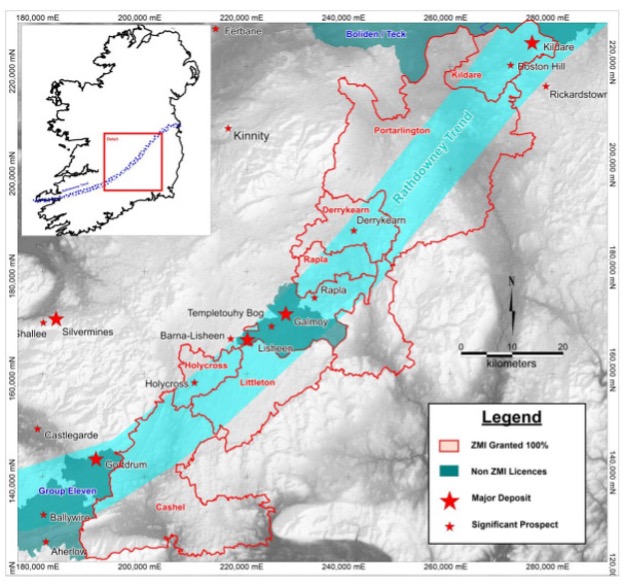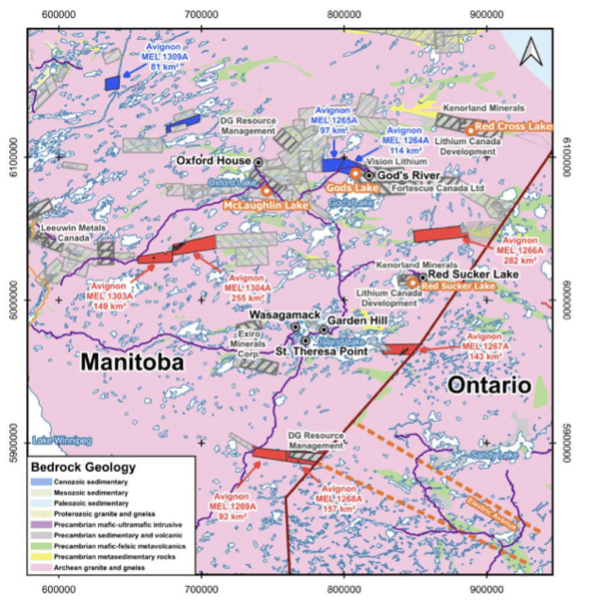Zinc of Ireland finds its own pot of gold with fresh germanium prospectivity at flagship Kildare zinc project
Mining
Mining
Special Report: Zinc prices may be in the doldrums, falling by almost a quarter in the past year, but that hasn’t deterred Zinc of Ireland (ASX:ZMI) from ramping up exploration programs at its flagship asset, southwest of Dublin, in the Irish Midlands.
ZMI was set up by Thomas Corr, now a non-executive director who has lived in Dublin for the past 14 years. The company’s Kildare project is situated on the 40km-long Rathdowney Trend within a short distance of several profitable zinc mines.
The Rathdowney structural belt encompasses major sulphide ore bodies and mineral deposits with companies like Canada’s largest mining giant Teck, Glencore, Vedanta and Swedish mining major Boliden all currently or previously exploring for resources in area.
Boliden owned what used to be Europe’s largest zinc mine, Tara, which extracted more than 85Mt of ore during its time before it was put on care-and-maintenance in 2023.
Until recently, ZMI’s focus at Kildare had been driven by its similarities to various high-grade mines nearby, including the 22.8Mt underground Lisheen mine and the 9.7Mt underground Galmoy mine.

While the Kildare project, strategically placed on the doorstep of the European Union, has a lot to offer with a well-defined 11Mt @ 9% zinc-lead brownfields resource, ZMI has uncovered another exciting prize.
“Ireland is an interesting place to work because it’s the biggest producer of zinc in Europe and it was, until recently, the sixth biggest producer in the world,” Corr tells Stockhead.
“The country has a strong history of zinc mining which means you get can stuff done from a mine permitting and exploration point of view so in that sense it’s a good jurisdiction to be in.
“But we’ve now been appraising the project for germanium which has come under the spotlight in recent times given the Chinese control over supply.
“The science is, where you have zinc, you also have germanium, so we’ve been spending time analysing key information from historical drilling that highlights some exceptional numbers.”
The spark that lit a fire under ZMI’s germanium light were findings from a ‘Critical Element Study’ carried out by geological consultancy, BRG.
Results obtained from pXRF analyses on 906 samples within areas of previously identified zinc-lead mineralisation revealed the potential of significant concentrations of germanium from all four key mineralised zones at Kildare.
Germanium is a critical mineral used in semi-conductor chips which are the building blocks for the technology used in IT, smartphones, EVs and military applications.
But like many of the world’s critical minerals, its supply chain falls under the grips of the Chinese government which banned exports of the metal in July last year as a retaliation tactic against the US and other countries after they imposed sanctions on China’s tech industry.
While the decision put semiconductor and defence industries at risk, it offered significant opportunity for miners looking to secure business, especially those readying to boost production.
The samples were taken from selected historic core within or adjacent to the Kildare resource block model and returned:
Prior to this commissioned test work, ZMI says none of the 50,000m of drill core from Kildare has been assayed for germanium.
“What we aim to do now is re-analyse the information and fast track our work programs, which means we won’t have to do as much exploration or drilling,” Corr says.
“We now have a high degree of confidence in our future work which will include selected resampling and convectional sample analyses of existing drill core.
“We are excited to use our existing data and drill core to expedite quantifying the germanium extent at potentially one of Europe’s largest undeveloped deposits.”
ZMI is branching out to investigate other critical minerals and regions around the globe as well, such as Canada’s Manitoba province where it has recently acquired some 1,380km2 of ground off the back of highly prospective lithium pegmatite showings.
“James Bay, as well as Electric Avenue over in Ontario, have both had a lot of mineral exploration activity but what many don’t realise is that Manitoba comprises very similar geology,” Corr says.
“There might be more discoveries over in those areas, but we’ve been able to have a big idea here.”
Manitoba, west of Ontario, has ready-built infrastructure and a long history of mining, yet is vastly underexplored for lithium.
Traditionally known for gold, copper and nickel deposits, the region is home to the world-class Tanco LCT mining operation which has been in operating for >50 years.
It also qualifies as compliant with the United States’ Inflation Reduction Act and Canada’s Critical Minerals Strategy, mechanisms that streamline and subsidise clean energy projects and provide tax incentives for resources projects.
ZMI’s new project consists of seven mining claims and six mineral exploration licences
(MELs) with another four MELs currently under application that are largely under explored for lithium.

Notably, the mining claims, which cover 1,792 hectares, are just 40km west of the world-class Tanco LCT mine.
Other ASX juniors that have trekked to the Canadian province include Leeuwin Metals (ASX:LM1), Burley Minerals (ASX:BUR), Koba Resources (ASX:KOB) and Native Mineral Resources (ASX:NMR).
Interestingly, Corr says iron ore giant Fortescue (ASX:FMG) has also moved into the area, pegging ground immediately behind ZMI’s ground.
“That’s a bit of proof of concept for us,” he says.
“We’re also close to legendary prospector Jody Dahrouge, one of the vendors of Patriot’s Corvette property, who is now an exploration consultant to the $551.8m company so we know we’re in the right geology surrounded by the right neighbours.
“We want to find the Corvette of Manitoba.”
Much of ZMI’s work to date in has been in the form of desktop surveys, which Corr says is a cheap and easy way to generate targets.
“The staking process over in Canada and the licences we’ve gone for are all desktop, but we’ve used domestic consultants to help generate the targets,” he says.
“We plan to head out in May during the North American field season to ground truth scalable outcropping targets to then follow up with drill testing.
“We’ve cast a big net which means we can scrutinise our targets quite heavily. We are looking for low hanging fruit here that would conceptually be of significant scale and generate favourable mining economics. Ideally, we want 100mt+ targets at or close to surface.”
This article was developed in collaboration with Zinc of Ireland, a Stockhead advertiser at the time of publishing.
This article does not constitute financial product advice. You should consider obtaining independent advice before making any financial decisions.